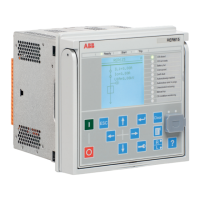faults. As data sheet impedance per unit values are generally valid only for
a certain tower configuration, the values should be adjusted according to the
actual installation configuration. This minimizes the fault location errors caused by
inaccurate settings.
The positive-sequence reactance per unit and per phase can be calculated with a
following approximation equation which applies to symmetrically transposed three-
phase aluminium overhead lines without ground wires.
X
a
r
km
n
en
1
4
10 2 0 5≈ ⋅ ⋅ +
−
ω
ln . [ / ]Ω
(Equation 59)
ω
n
2 × π × f
n
, where f
n
= fundamental frequency [Hz]
a
en
the geometric average of phase distances [m]
a
xy
distance [m] between phases x and y
r radius [m] for single conductor
Figure 254: Typical distribution line tower configurations
Example values of positive-sequence impedances for typical medium voltage
overhead-lines are given in the following tables.
Table 534: Positive-sequence impedance values for typical 11 kV conductors, “Flat”
tower configuration assumed
Name R1 [Ω/km] X1 [Ω/km]
ACSR 50 SQ.mm 0.532 0.373
ACSR 500 SQ.mm 0.0725 0.270
1MRS758755 C Protection related functions
REC615 & RER615
Technical Manual
507

